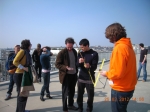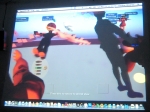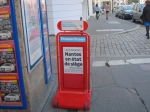Internet Auditoriums – Locus Sonus
Posted: March 28, 2012 Filed under: Conferences, Presentations, Uncategorized | Tags: Conferences, Nantes, networked performances Leave a comment(En español abajo)
Sounding Underground was presented last weekend in the Internet Auditoriums Symposium, along with Networked Migrations. The spaces that these two projects create can be understood as Internet Auditoriums. Here the abstract of the paper. In the symposium we were listening to Interconnected Auditoriums which create a space for collective listening, using the Internet or not, with and without wires; listening collectively to the body (in hammocks), listening to the cloud, listening to real-fiction in Berlin, listening to twitterscapes, listening to the dreams, listening to all abilities, listening to Brazil, listening to sounds of childhood, listening to the tiny movements of the Big Ben, to Venice, and to the musicality of the languages that is extracted from the non-sense. We also listened to the strike and the protest in Nantes against the construction of the Airport. Interconnected listening makes the nature of sounds migratory, do we travel with them?. Rich, ethereal, complex, fragile, metaphoric, poetic and politic auditoriums. A delicious time of learning in Nantes! Many thanks to Locus Sonus team and to all the participants! and to the city of the giant Elephant!

Networked Migrations fue presentado el fin de semana pasado en el Symposium Internet Auditoriums, con Sounding Underground. Los espacios que estos dos proyectos crean pueden ser entendidos como Internet Auditoriums. Aqui esta el abstract de la presentación. En el Symposium escuchamos Auditorios Interconectados, los cuales crean espacio para la escucha colectiva, usando o no el Internet, con y sin cables; escuchando colectivamente al cuerpo (en hamacas), escuchando a la ‘cloud’, escuchando a ficción-realidad en Berlin y a twitterscapes, escuchando a los sueños, a todas las habilidades, escuchando a Brasil, y a los sonidos de la niñez; también a los sonidos imperceptibles del Big Ben, a Venezia, y a la musicalidad de los idiomas que se extrae del sin sentido. Escuchamos también a Nantes en huelga, en protesta por la construcción del aeropuerto. Escucha interconectada hace que la naturaleza de los sonidos se vuelva migratoria, viajamos con ellos?. Ricos, etéreos, complejos, frágiles, metafóricos, poéticos y políticos; así son estos auditorios. Un tiempo delicioso de aprendizaje en Nantes! Muchas gracias, merçi! al equipo de Locus Sonus y a todos los participantes! y a la ciudad del elefante gigante!
Arte Transversal – Transdisciplinary Art – Mexico
Posted: July 1, 2011 Filed under: Uncategorized | Tags: Conferences, Mexico, Veracruz Leave a commentSee English – below
A principios de Junio tuve el placer de compartir mi experiencia de creación transdisciplinar y de enseñanza a nivel de Master, en el Primer Encuentro de Arte Transversal en el Centro Nacional de las Artes – CENART, y en el Centro Veracruzano para las Artes – CEVART. Mi charla se tituló “Justo en el Medio, prácticas creativas con tecnologías y sus vertientes transdisciplinarias”. Aquí puede acceder a la presentación.
El innovador Diplomado Tránsitos es ofrecido para profesionales de las artes, quienes desarrollan sus proyectos con una estructura no usual, empezando por los nombres de las estructuras modulares llamadas nodos, y la variedad de oportunidades de aprendizaje que los estudiantes tienen. Esta flexibilidad ofrece el campo perfecto para la creación de ideas innovadoras y proyectos donde las artes y disciplinas se cruzan. Es un espacio de práctica pedagógica dinámica. Proyectos como “El Hoyo” y “Todo lo que brilla es oro”, son resultado de práctica transversal.
English
In June I had the pleasure to share my experience as transdisciplinar artist and programme leader in the IOCT Masters in Creative Technologies (in 2010), during the first Summit of Arte Transversal, in the CENART (National Centre for the Arts), in Mexico, City, and in the CEVART (Centre for the Arts in Veracruz). The title of my talk: “Just in the Middle, creative practice with technologies and their transdiciplinary crossings”. Here, you can access to the presentation.
The innovative postgraduate course Tránsitos is offered to arts proffesionals, who develop their projects in an unusual structure, with Modules that offer variety of learning experiences. The flexible structure offers the perfect environment to create innovative projects where arts and other disciplines criss-cross. Projects such as “El Hoyo” and “Todo lo que brilla es oro”, are the result of this practice.
Mexico and New Orleans – Listening practice & Cross-disciplines
Posted: November 28, 2010 Filed under: Conferences | Tags: Anthropology, Conferences, Ethnography, Mexico, Morelia, New Orleans, Paisaje Sonoro, Soundscape, Transdiciplinary Leave a commentI had the great experience of giving a talk in the festival Visiones Sonoras organised by the CMMAS in Morelia – México. Sounding Underground makes connections between people and their current or lost acoustic environments. Interesting questions about its performative function, and the possibilities of the networks are still in my mind. I enjoyed the emphasis placed on the instruments and objects in all the pieces of the Electroacoustic Concert 5 , it connects me more with the performance.

One day later, I presented a paper about Sounding Underground in the IV Encuentro Iberoamericano de Paisaje Sonoro organised by the Fonoteca Nacional in Mexico City. A very diverse and interesting cross-disciplinary and cross-arts reflection about “Paisaje Sonoro” (Soundscape). Excellent speakers and attendants, a learning experience about listening and creating: Whales, Flamencos, Veracruz, San Juan Potosí, Islas Resonantes, Bells (Chile and Mexico), Cartography Mobile experiences, Water, an Electroacoustic concert in 10.0 and lessons about Silence.
Last but not least, I attended to the American Anthropological Association AAA Conference in New Orleans, as speaker in the Session: “Perception, production and circulation: Sensory Ethnography through media” organised by Julia Yezbick and Aryo Danusiri from Harvard University. Sensory Ethnography is a new field where Sounding Underground experience fits very well, and gets nourishment from Anthropology.
Thanks to all the organisers and great people that I met through all these three wonderful events.
IBM social software unconference
Posted: September 22, 2010 Filed under: Conferences | Tags: Boston, Conferences, migration Leave a commentOrganised by Andrew Sempere. Thanks!
My three words… listening, underground, migration… I think.
Session Identity, territory and social migration (Ximena + Edith)
and my tweet:
“Democracies should be undemocracies”
Keynote speaker: Amanda Palmer!!
Great people, talks and conversations.
Hoping to follow and maintain links!
Royal Geographical Society – Sonic Methods
Posted: September 15, 2010 Filed under: Conferences, Presentations | Tags: Conferences, Geography, London, Sound Environments 1 Comment“Sounding Underground: Listening, performing and transforming” was the paper given in the Annual International Conference of the Royal Geographical Society in London. The Session “Sonic Methods” organised by Michael Gallagher and Jonathan Prior, was a rich environment to share different methods that study our acoustic experiences and their cultural and artistic value. At the end of the day we had a one minute recording experiment with loop tapes. A real challenge!
The Theme of the conference was sustainability, and perhaps this last exercise proposed by Michael Gallagher, is a representation of old media and its degradation, the qualities of degradation and a technology that records just one minute making of it ephemeral in the recording but rich in the experience. If you just have one minute in a tape to record, what would you record?
This experience is so refreshing in this digital world where “memory” is a commodity, as regards machines, and our own “memory” can get lost in a (too much) over information. The importance of reflect, and listen to each moment as if it was the last minute available to listen…
Qualitative Research in web 2.0: the next leap, Berlin 2010
Posted: April 12, 2010 Filed under: Uncategorized | Tags: Berlin, Conferences Leave a commentI had the pleasure of attending the conference Qualitative Research 2.0: the next leap, in Berlin, organised by the Merlien Institute. With the participation of both marketing researchers and academic researchers, we reflected critically on the possibilities and social issues of conducting qualitative research using web 2.0 tools.
My paper: “From the underground to the Internet: issues of ethnography, ethics and identities”. It was welcomed as an excellent example of the use of ethnography and the internet.
A good strategy offered by the organiser Jasper Lim was to leave the conference with “take aways”, which I found very helpful and innovative. Well, here are my “take aways”:
1. Web 3.0 is envisioned as a performative space for individuals. Ethnography and art are well suited for this vision! This is a plus-plus take away for Sounding Underground!
2. Best approaches to qualitative research using web 2.0 tools were identified as hybrids, and dependent on the context and the participants (off-line and on-line).
3. There was a “Theory of Technique”: some web tools work better than others for particular objectives in a research, e.g. real time or asynchronous.
4. Identities: imagined, constructed, and real. How much social healing can be derived from this amazing research?
5. Politics: Using Social Media as political marketing, but also as a way of bringing people closer to the candidates. A new and exciting research topic. This is an important year for many countries with regards to elections: Lithuania, the UK and Colombia! Are social media, politically speaking, equally influential in developed and developing countries?
Thanks to all the participants! this was a truly nourishing conference!
The Berlin u-bhan (metro), without barriers (turnstiles, obstacles) when commuting. How much Berlin has to teach the world about breaking walls! A powerful and admirable city. Thanks Berlin!
















You must be logged in to post a comment.